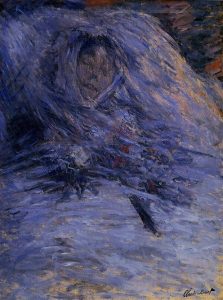“And now she desires nothing more than to remain there crucified to the earth, suffering and enjoying in her flesh the ebb and flow of distant, far distant tides; feeling the grass grow, new islands emerge, and on some other continent, the unknown flower bursting open that blooms only on a day of eclipse. And she even feels huge suns boiling and exploding and gigantic mountains of sand tumbling down, no one knows where” (259)
No matter how much you try, one cannot escape the cold grasp of death. It is a fate that Ana Maria so desperately tries to challenge. The “Shrouded Woman” is an unescapable march to the afterlife. The section of the novel presents itself as the tragic retelling of Ana Maria’s tragic life. The all around emotion of this book is despair. There are many instances of “what could have been” – the general structure of this book seeming like a final goodbye, which it is. At the beginning some may call Ana Maria whiny; exhibiting a general distain for life. However, reading deeper, Ana Maria’s life is that of a Shakespearean Tragedy.
Despair fills her entire view: her daughter-in-law dying by suicide; her husband “tolerating” her; the summer romance shared and never again fulfilled. “Isn’t it strange a love that can humiliate, can do nothing but humiliate” (205). Her hopeful wishes are torn down every chance; Ana Maria symbolically is hiding herself (shrouding) in gloom.
Following the end of the story, we are shown a glimpse into Ana Maria’s relationship with god. This quote is a summary of her pain: “The Garden of Eden! Poor Ana Maria! Your whole life was nothing but a passionate search for that Garden of Eden, lost irretrievably, however, by man!” (254). She is cursed with the journey to find Eden; to find lust, desire, perhaps love. But, at every turn, she is tricked. She cannot find the garden because it has been overtaken by the selfish nature of man. Ricardo will never love her as she loved him; Antonio will always be resentful, barely tolerating his wife; and Fernando, the yearning of a true friend.
Limbo: in an uncertain or undecided state or condition (Merriam-Webster)
This is where Ana Maria is, until the end of the novel. She teeters dead; on the edge of remembrance and disappearance. It is the fate of the Shrouded woman: to recount the live moments of her deadly life. She can rest, knowing that her second death is here.
“I swear it. The woman in the shroud did not feel the slightest desire to rise again. Alone, she would at last be able to rest, to die. For she had suffered the death of living. And now she longed for total immersion, for the second death, the death of the dead” (259)
Discussion Question:
The Shrouded Woman is a play on two meanings: one being literally shrouding herself (wrapping the woman up for death) and additionally shrouding the self (hiding from the world). Why do you think Bombal emphasizes this point so hard? It is a further commentary on death and life and the similarities between the two?
This painting I have here is one by Claude Monet entitled: “Camille Monet on her Deathbed”. It is a painting of his late wife who tragically died at 32. This painting represents the reality of death: corpses decay as death is inevitable. It is a painting of true despair


Gabby, thank you for your thoughtful reflection on death and what comes after. Great choice of painting to engage with the text!